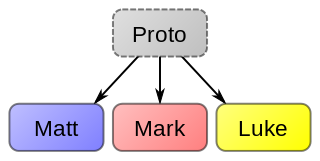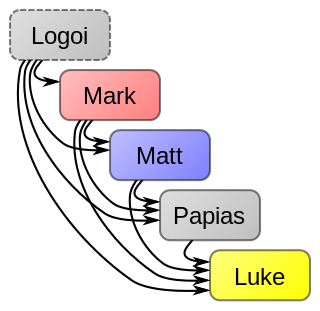Related Research Articles
Gospel originally meant the Christian message, but in the 2nd century it came to be used also for the books in which the message was reported. In this sense a gospel can be defined as a loose-knit, episodic narrative of the words and deeds of Jesus, culminating in his trial and death and concluding with various reports of his post-resurrection appearances. Modern biblical scholars are cautious of relying on the gospels uncritically, but nevertheless, they provide a good idea of the public career of Jesus, and critical study can attempt to distinguish the original ideas of Jesus from those of the later Christian authors.

Marcan priority is the hypothesis that the Gospel of Mark was the first of the three synoptic gospels to be written, and was used as a source by the other two. It is a central element in discussion of the synoptic problem; the question of the documentary relationship among these three gospels.
Burton L. Mack was an American author and scholar of early Christian history and the New Testament. He was John Wesley Professor emeritus in early Christianity at the Claremont School of Theology in Claremont, California. Mack was primarily a scholar of Christian origins, approaching it from the angle of social group formation. Mack's approach was skeptical, and he saw traditional Christian documents like the Gospels as myth as opposed to history. He viewed the gospels more as charter documents of the early Christian movements, not as reliable accounts of the life of Jesus.

The Gospel of Thomas is an extra-canonical sayings gospel. It was discovered near Nag Hammadi, Egypt, in December 1945 among a group of books known as the Nag Hammadi library. Scholars speculate that the works were buried in response to a letter from Bishop Athanasius declaring a strict canon of Christian scripture. Scholars have proposed dates of composition as early as 60 AD and as late as 250 AD. Since its discovery, many scholars have seen it as evidence in support of the existence of a "Q source" which might have been very similar in its form as a collection of sayings of Jesus without any accounts of his deeds or his life and death, referred to as a sayings gospel.

The Jesus Seminar was a group of about 50 biblical criticism scholars and 100 laymen founded in 1985 by Robert Funk that originated under the auspices of the Westar Institute. The seminar was very active through the 1980s and 1990s, and into the early 21st century.

The two-source hypothesis is an explanation for the synoptic problem, the pattern of similarities and differences between the three Gospels of Matthew, Mark, and Luke. It posits that the Gospel of Matthew and the Gospel of Luke were based on the Gospel of Mark and a hypothetical sayings collection from the Christian oral tradition called Q.

The gospels of Matthew, Mark, and Luke are referred to as the synoptic Gospels because they include many of the same stories, often in a similar sequence and in similar or sometimes identical wording. They stand in contrast to John, whose content is largely distinct. The term synoptic comes via Latin from the Greek σύνοψις, synopsis, i.e. "(a) seeing all together, synopsis"; the sense of the word in English, the one specifically applied to these three gospels, of "giving an account of the events from the same point of view or under the same general aspect" is a modern one.

The Farrer hypothesis is a possible solution to the synoptic problem. The theory is that the Gospel of Mark was written first, followed by the Gospel of Matthew and then by the Gospel of Luke.

M source, which is sometimes referred to as M document, or simply M, comes from the M in "Matthean material". It is a hypothetical textual source for the Gospel of Matthew. M Source is defined as that 'special material' of the Gospel of Matthew that is neither Q source nor Mark.

John Dominic Crossan is an Irish-American New Testament scholar, historian of early Christianity, former Catholic priest who was a prominent member of the Jesus Seminar, and emeritus professor at DePaul University. His research has focused on the historical Jesus, the theology of noncanonical Gospels, and the application of postmodern hermeneutical approaches to the Bible. His work is controversial, portraying the Second Coming as a late corruption of Jesus' message and saying that Jesus' divinity is metaphorical. In place of the eschatological message of the Gospels, Crossan emphasizes the historical context of Jesus and of his followers immediately after his death. He describes Jesus' ministry as founded on free healing and communal meals, negating the social hierarchies of Jewish culture and the Roman Empire.
The criterion of multiple attestation, also called the criterion of independent attestation or the cross-section method, is a tool used by Biblical scholars to help determine whether certain actions or sayings by Jesus in the New Testament are from the Historical Jesus. Simply put, the more independent witnesses that report an event or saying, the better. This criterion was first developed by F. C. Burkitt in 1906, at the end of the first quest for the historical Jesus.
John S. (Seargeant) Kloppenborg is a Canadian professor of Religious Studies with expertise in Greco-Roman culture, Judean culture and Christian Origins, particularly the synoptic gospels and Q-source. He is presently at the University of Toronto, where he holds the distinguished title of "University Professor." He was elected a member of the Studiorum Novi Testamenti Societas in 1990, and was elected as a Fellow of the Royal Society of Canada in 2014. In 2019-2020 he served as the president of the Studiorum Novi Testamenti Societas. He is also a member of The Context Group, the Society of Biblical Literature, and the Canadian Society of Biblical Studies. He was awarded honorary doctorates from the University of Lethbridge (2011) and the University of Pretoria (2018)
Source criticism, in biblical criticism, refers to the attempt to establish the sources used by the authors and redactors of a biblical text. It originated in the 18th century with the work of Jean Astruc, who adapted the methods already developed for investigating the texts of classical antiquity to his own investigation into the sources of the Book of Genesis. It was subsequently considerably developed by German scholars in what was known as "the higher criticism", a term no longer in widespread use. The ultimate aim of these scholars was to reconstruct the history of the biblical text and also the religious history of ancient Israel.

The three-source hypothesis is a candidate solution to the synoptic problem. It combines aspects of the two-source hypothesis and the Farrer hypothesis. It states that the Gospel of Matthew and the Gospel of Luke used the Gospel of Mark and a sayings collection as primary sources, but that the Gospel of Luke also used the Gospel of Matthew as a subsidiary source. The hypothesis is named after the three documents it posits as sources, namely the sayings collection, the Gospel of Mark, and the Gospel of Matthew.

The Jerusalem School Hypothesis is one of many possible solutions to the synoptic problem, that the Gospel of Luke and the Gospel of Matthew both relied on older texts which are now lost. It was developed by Robert Lindsey, from the Jerusalem School of Synoptic Research.

The two-gospel hypothesis or Griesbach hypothesis is that the Gospel of Matthew was written before the Gospel of Luke, and that both were written earlier than the Gospel of Mark. It is a proposed solution to the synoptic problem, which concerns the pattern of similarities and differences between the three Gospels of Matthew, Mark, and Luke. The hypothesis is generally first credited to Johann Jakob Griesbach writing in the 1780s; it was introduced in its current form by William R. Farmer in 1964 and given its current designation of two-gospel hypothesis in 1979.

The Q source (also called The Sayings Gospel, Q Gospel, Q document(s), or Q; from German: Quelle, meaning "source") is a hypothetical written collection of primarily Jesus' sayings (λόγια : logia). Q is part of the common material found in the Gospels of Matthew and Luke but not in the Gospel of Mark. According to this hypothesis, this material was drawn from the early Church's oral gospel traditions.

In textual criticism of the New Testament, the L source is a hypothetical oral or textual tradition which the author of Luke–Acts may have used when composing the Gospel of Luke.

The Hebrew Gospel hypothesis is that a lost gospel, written in Hebrew or Aramaic, predated the four canonical gospels. Some have suggested a complete unknown proto-gospel as the source of the canonical gospels. This hypothesis is usually based upon an early Christian tradition from the 2nd-century bishop Papias of Hierapolis. According to Papias, Matthew the Apostle was the first to compose a gospel, and he did so in Hebrew. Papias appeared to imply that this Hebrew or Aramaic gospel was subsequently translated into the canonical Gospel of Matthew. Jerome took this information one step further and claimed that all known Jewish-Christian gospels really were one and the same, and that this gospel was the authentic Matthew. As a consequence he assigned all known quotations from Jewish-Christian gospels to the "gospels of the Hebrews", but modern studies have shown this to be untenable. Modern variants of the hypothesis survive, but have not found favor with scholars as a whole.

Advanced by Dennis R. MacDonald, the Q+/Papias hypothesis (Q+/PapH) offers an alternative solution to the synoptic problem. MacDonald prefers to call this expanded version of Q Logoi of Jesus, which is supposed to have been its original title.
References
- 1 2 3 4 5 6 7 8 9 Crossan, John Dominic. The Birth of Christianity: Discovering What Happened in the Years Immediately After the Execution of Jesus. San Francisco: HarperSanFrancisco, 1998.
- ↑ Linssen, Martijn (2020-08-12). "The 72 logia of Thomas and their canonical cousins". Absolute Thomasine priority. Part III: 141 – via academia.edu.
- 1 2 3 4 5 6 McLean, Bradley H. The Gospel Behind the Gospels: Current Studies on Q (Novum Testamentum, Supplements, 75). Leiden: Brill Academic Publishers, 1995.
- ↑ Kloppenborg, John S. Q, the Earliest Gospel: An Introduction to the Original Stories and Sayings of Jesus. Louisville: Westminster John Knox Press, 2008. Pg. 107
- 1 2 3 4 5 6 7 DeConick, April D. Recovering the Original Gospel of Thomas: A History of the Gospel And Its Growth (The Library of New Testament Studies). Edinburgh, Scotland: T. & T. Clark Publishers, 2006.
- ↑ Bultmann, Rudolf. History of the Synoptic Tradition. New York: Harper & Row, 1963. Pg 31.
- ↑ Koester, Helmut. Ancient Christian Gospels: Their History and Development. Philadelphia: Trinity Press International, 1990. pg. 95.
- 1 2 Loader, William. "Simple Choices: A response to John Dominic Crossan." Colloquium 31.2 (1999): 67-74.
- 1 2 3 4 Mount, Christopher. "[Untitled Review]." The Journal of Religion 80.1 (2000): 110-120. pg. 119.